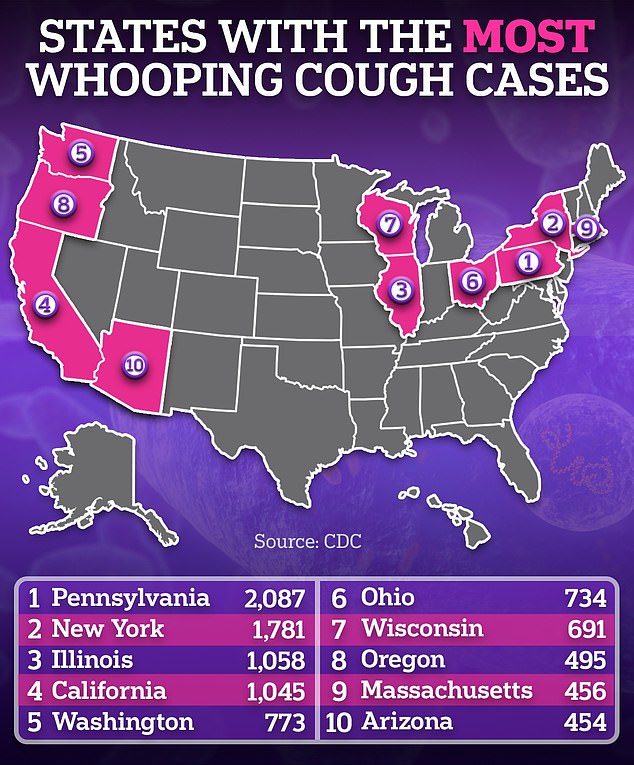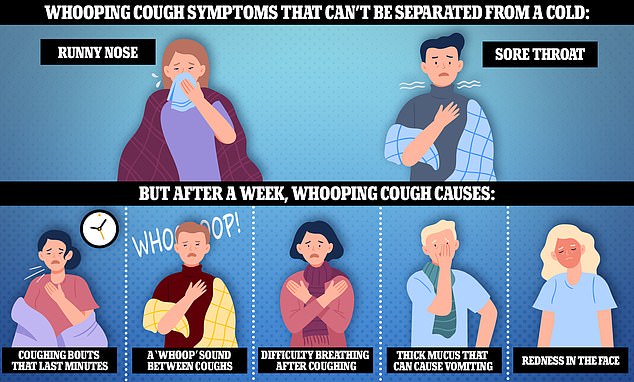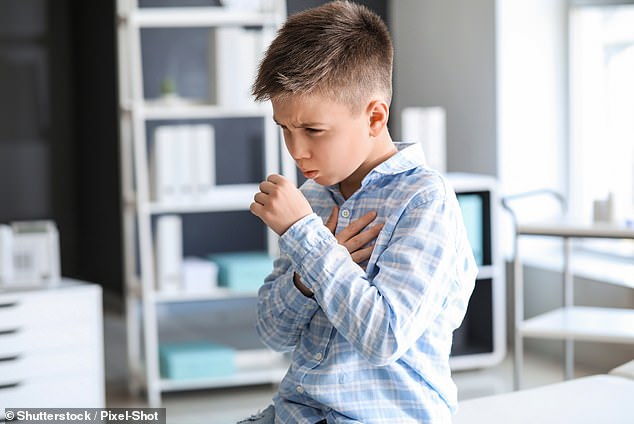Cases of a highly contagious Victorian-era disease have quintupled compared to last year, health officials warn.
The CDC said the United States has recorded more than 15,000 cases of whooping cough in 2024 so far, compared to 3,600 this time last year.
Although children are supposed to be vaccinated before starting primary school, officials noted that there has been a drop in vaccination rates after the Covid pandemic.
Rates of the disease, which affects all ages but is most dangerous for young children, were highest in Pennsylvania, with just over 2,087 cases.
New York and Illinois followed closely with 1,781 and 1,058 cases, respectively.
The disease kills about one in every 100 babies who become infected, including at least one baby in Alaska earlier this month, where rates have increased 70-fold. Last year, three children were killed.
According to the latest CDC data, pertussis rates in the US are five times higher than this time last year (file image)

The bacterial disease, also known as whooping cough, was common in the 20th century and had previously been controlled by vaccination.
But experts warn that the increase could be attributed to more parents choosing not to vaccinate their children against whooping cough after the pandemic, as well as the disease becoming more active and better at evading vaccines.
The findings come after Idaho officials warned that cases in the state were 17 times higher than this time last year. According to CDC data, Idaho has seen 230 cases so far in 2024, compared to 13 at this time last year.
Whooping cough occurs when bacteria attach to small hairs in the throat and nose and release toxins that cause inflammation of the airways.
At first, this may cause mild symptoms such as a runny nose or mild cough, but it can progress to a cough so violent that it leads many patients to vomit and develop breathing problems.
According to the latest data from the CDC, 15,661 cases of whooping cough have been reported so far this year, compared to 3,635 at this time last year.
In Pennsylvania, whooping cough cases increased from 198 this time last year to 2,087, a more than 10-fold increase.
Of the cases in New York, about one in three were concentrated in New York City, the data shows.
California and Washington state rounded out the five states with the highest rates, recording 1,045 and 773 cases, respectively.
Regional data shows that the Mid-Atlantic states (New Jersey, New York and Pennsylvania) had the most cases, with 3,996.
And although it didn’t make the top 10, Alaska saw the largest increase. At this time last year, the state reported only four cases. However, so far this year there have been 297, almost 70 times more than the previous year.

Health officials warned that it is initially difficult to differentiate the infection from a cold, as the first signs are a runny nose and sore throat. But about a week later, patients may develop coughing fits that last minutes, have difficulty breathing after coughing, and make a “screaming” sound between coughs.
Experts have suggested the rise may be due to parents becoming more wary of vaccines after the Covid pandemic.
Dr. Tina Tan, president-elect of the Infectious Diseases Society of America, said NBC News: “With the increase in vaccine hesitancy that has occurred since the Covid-19 pandemic, we are seeing outbreaks in children who are not vaccinated.”
The CDC said that “vaccination is the best way to prevent whooping cough.” This is the Tdap (tetanus, diphtheria, pertussis) vaccine, which is usually given to infants, adolescents, and adults as a booster every 10 years.
However, the CDC also noted that the bacteria that causes whooping cough, Bordetella pertussis, is prone to mutations, which could allow it to evade vaccines.
FDA advisers met last month to discuss the need for longer-lasting vaccines, NBC News reported.
Despite the grim statistics, not all states saw increases. Nevada, for example, has reported only six cases so far, compared to 31 at this time last year.
Additionally, Utah has reported slightly fewer cases this year, 145 compared to 172 last year.


